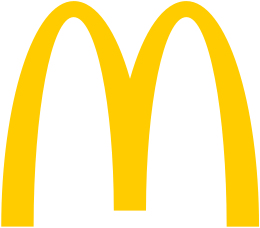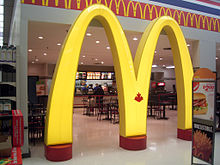Golden Arches

The Golden Arches are the symbol of McDonald's, the global fast food restaurant chain. Originally, real arches were part of the restaurant design. They were incorporated into the chain's logo in 1962, which resembled a stylized restaurant, and in the current Golden Arches logo, introduced 1968, resembling an "M" for "McDonald's". They are widely regarded to be one of the most recognizable logos in the world.
History
In 1952, brothers Richard and Maurice McDonald decided they needed a new building to house their hamburger restaurant in San Bernardino, California. They wanted this building to have an entirely new design which would achieve two goals: even greater efficiency, and an eye-catching appearance. They interviewed at least four architects altogether, finally choosing Stanley Clark Meston, an architect practicing in nearby Fontana, in late 1952. The arches had a direct bearing on the interviewing process and their choice of Meston: the first architect they interviewed objected to the arches the brothers wanted; a second wanted to change the arches; a third, prominent Los Angeles architect Douglas Honnold, said that if the brothers were going to tell him what to do they would be better off doing it themselves.[1]

Along with their practical knowledge, the brothers brought Meston a rough sketch of two half-circle arches drawn by Richard. The idea of an arch had struck Richard as a memorable shape to make their stand more visible. After considering one arch parallel to the front of the building, he had sketched two half-circles on either side of the stand.[1] Meston, together with his assistant Charles Fish, responded with a design which included two 25-foot (7.6 m) yellow sheet-metal arches trimmed in neon, called "golden arches" even at the design stage. His design also included a third, smaller arch sign at the roadside with a pudgy character in a chef's hat, known as Speedee, striding across the top, trimmed in animated neon.
According to architectural historian Alan Hess, "Meston and Fish turned the crude half-circle suggested by Richard McDonald's sketch into a tapered, sophisticated parabola, with tense, springing lines conveying movement and energy."[1] In the same article Hess added this footnote: "Who first suggested the parabola is unclear. Richard McDonald and George Dexter, the sign contractor who fabricated the first arches, recalled that Dexter came up with the idea and added them to the plans. Charles Fish, who did the working drawings and aided Meston in the design, attributes the idea to his familiarity with the form from a school project in which he used structural parabolas for a hangar. The form was one of many advanced engineering solutions, including folded plate roofs, that were in common currency."[1]
The first franchised outlet bearing Meston's design opened in May 1953 in Phoenix, Arizona. Subsequent franchisees of the McDonald brothers were also required to use Meston's design, although Meston adapted the plans for each to the conditions and building codes of each site.[1]

In 1962, seeking to upgrade its image, the company sought a new logo. Fred Turner sketched a stylized "V", but the company's head of engineering and design, Jim Schindler, extended the "V" into an "M" resembling a McDonald's store viewed from an angle, with a red isosceles trapezoid "roof" serving as background for lettering.[2]
While McDonald's dropped the physical arches from nearly all of its restaurants in the 1960s[citation needed], the Golden Arches have remained in the logo, and as a commonly understood term for the company. This was partially due to Louis Cheskin's argument that the arches, which he likened to "mother McDonald's breasts", had "Freudian applications to the subconscious mind of the consumer and were great assets in marketing McDonald's food."[3]
Alan Hess summarized the arch's origin in Googie architecture and ultimate significance as follows:
The arch was conceived by businessman Richard McDonald, an untrained designer with no knowledge of erudite architectural examples. His intent was pragmatic: to be noticed. This determined its scale, position, and simple shape visible over long distances following the precedent of earlier drive-ins with which he was familiar. To McDonald, the arch was an arbitrary form, without symbolic or historic associations, which he hoped would come to symbolize McDonald's. The arches' position implies no traditional use of the arch as an entry, nor are they structural. The architect delineated this formal concept determined by the client in the energetic lines and machine-like surfaces of a popular commercial vernacular style current in the 1940s and 1950s ... Meston's design proved successful as design and icon because of, not in spite of, its commercialism.[1]
Variations

All restaurants operated by McDonald's Canada use a variation of the Golden Arches, which features a maple leaf inserted into the centre of the Golden Arches; subsuming a Canadian national symbol into its corporate symbol.[4]

The McDonald's arches in Sedona, Arizona, were made turquoise when the yellow color had been deemed by government officials to be contrasting too much against the scenic red rock.[5]
As of 2019, seven McDonald's signs only have one arch, including locations in Magnolia, New Jersey; Winter Haven, Florida; Montrose, Colorado; and McDonald's sign in Pine Bluff, Arkansas.[6]
The McDonald's restaurant at 610 Del Monte Ave., Monterey, California, has black arches.[7]
The McDonald's in North Scottsdale, Arizona, on 18241 N Pima Rd also has black arches.[8][better source needed]
The McDonald's restaurant at 2172 Sunset Blvd. in Rocklin, California, has dark red arches.[9][better source needed]
The restaurant at Champs-Elysées in Paris, France, includes a neon McDonald's sign with white arches. Also, a recently[when?] built McDonald's in Bruges, Belgium, has white arches.[10]
In 2017, McDonald's China Division was renamed to Golden Arches while keeping the restaurant's name as McDonald's.[11] McDonald's spokesperson explained that the rename was due to McDonald's Corporation sold bulk of its China Division to CITIC Group and Carlyle Capital.[12]
In 2018 and again in 2019, McDonald's turned the arches upside down on its social media accounts in celebration of International Women's Day, changing the "M" to a "W." A McDonald's franchise operated by Patricial Williams in Lynwood, California, also flipped the arches on its sign.[13][14] This prompted a mild backlash, with some arguing that the move was hypocritical due to the chain's underpaying of employees, and others observing that the "M" in the logo could just as easily stand for "men" as it could for "McDonald's."[15]
Influence

The term "Golden Arches" is sometimes used as metonym, symbolizing capitalism and globalization.[16][17] In phrases such as the "Golden Arches Theory of Conflict Prevention", it is asserted that "No two countries that both had McDonald's had fought a war against each other since each got its McDonald's". McDonald's Golden Arches is used as it is one of the more prominent American corporations that have become global in their reach (along with Coca-Cola and Nike).
The shape and color of the prominent space frame trusses used in the heavy-lift ship VB-10,000 have led some to nickname it the "Golden Arches".[18][19][20]
References
- ^ a b c d e f Hess, Alan (March 1986). "The Origins of McDonald's Golden Arches". Journal of the Society of Architectural Historians. 45 (1): 60–67. doi:10.2307/990129. JSTOR 990129.
- ^ Mark Hughes (January 4, 2008). "Logos that became legends: Icons from the world of advertising". The Independent. Archived from the original on October 3, 2009. Retrieved April 27, 2008.
- ^ "Brand iconography - the secret to creating lasting brands?". Brand Strategy. February 20, 1999. Archived from the original on April 9, 2016.
- ^ Barndt, Deborah (2008). Tangled Routes: Women, Work, and Globalization on the Tomato Trail. Rowman & Littlefield Publishing. p. 100. ISBN 9780742555570.
- ^ Mary Kinney (15 July 2016). "Turquoise McDonald's arches ordered in Arizona town". AOL. Archived from the original on 28 June 2018. Retrieved 5 September 2014.
- ^ Strunsky, Steve (10 December 2018). "Only 7 original McDonald's golden arches still exist, and one is in N.J." NJ.com. Archived from the original on 23 August 2021. Retrieved 23 August 2021.
- ^ Lane Wallace (February 13, 2010). "One-of-a-kind design for new McDonald's in Monterey". Monterey Herald. Archived from the original on February 16, 2010. Retrieved September 5, 2014.
- ^ "Google Maps link (Photos of building exterior in listing)". Archived from the original on February 4, 2024. Retrieved April 12, 2022.
- ^ "Google Maps link (Photos of building exterior in listing)". Archived from the original on April 5, 2022. Retrieved July 10, 2020.
- ^ "Paris has what is thought to be the only McDonald's with white arches in place of their traditional golden ones". Archived from the original on September 5, 2014. Retrieved September 5, 2014.
- ^ "'Golden Arches': McDonald's gets new China name following unit sale". Reuter's. 26 October 2017. Archived from the original on 4 July 2023. Retrieved 4 July 2023.
- ^ Chen, Na (26 October 2017). "McDonald's Changes Its China Company Name to 'Golden Arches'". Six Tone. Archived from the original on 4 July 2023. Retrieved 4 July 2023.
- ^ Kate Taylor (March 9, 2019). "McDonald's is flipping its iconic arches upside down again for International Women's Day". Business Insider. Archived from the original on April 2, 2019. Retrieved April 2, 2019.
- ^ Abigail Hess (March 7, 2018). "McDonald's is turning its golden arches upside down to make a statement". CNBC. Archived from the original on April 2, 2019. Retrieved April 2, 2019.
- ^ Natasha Bach (March 7, 2018). "Why McDonald's International Women's Day Celebration Isn't Going as Planned". Fortune. Archived from the original on April 2, 2019. Retrieved April 2, 2019.
- ^ "Planet Mac". The Guardian. 2001-04-06. ISSN 0261-3077. Archived from the original on 2023-07-02. Retrieved 2023-07-02.
- ^ Glancey, Jonathan. "The strange story of the world's most famous logo". www.bbc.com. Archived from the original on 2023-07-02. Retrieved 2023-07-02.
- ^ "Golden arches causing a stir in the Gulf". The Lafourche Gazette. 4 October 2013. Archived from the original on August 22, 2016. Retrieved 1 August 2016.
If you were travelling along Louisiana's coast last week, you may have seen giant golden arches floating in the Gulf of Mexico. No, McDonalds did not open an offshore location. The arches are actually those of the VB 10,000 – a massive, floating piece of equipment that is used for salvaging and decommissioning oil platforms.
- ^ Lammey, Mark (February 11, 2020). "Versabar gears up for another crack at North Sea market". Energy Voice. Archived from the original on 11 August 2022. Retrieved 25 January 2023.
[Versabar] has decommissioned more than 200 platforms in the Gulf of Mexico (GoM) using its VB-4000 vessel, aka Bottom Feeder, VB-10000, nicknamed Golden Arches, and third party crafts.
- ^ Miller, Kimberly (November 10, 2021). "Mystery solved: Beachgoers see odd giant structure float by Palm Beach County's coast". The Palm Beach Post. Archived from the original on 2 June 2023. Retrieved 25 January 2023.
It appeared on the horizon last week like a massive floating ERECTOR Set, or golden arches for the world's largest McDonald's or a seaworthy amusement park ride.
External links
![]() Media related to Golden Arches at Wikimedia Commons
Media related to Golden Arches at Wikimedia Commons
